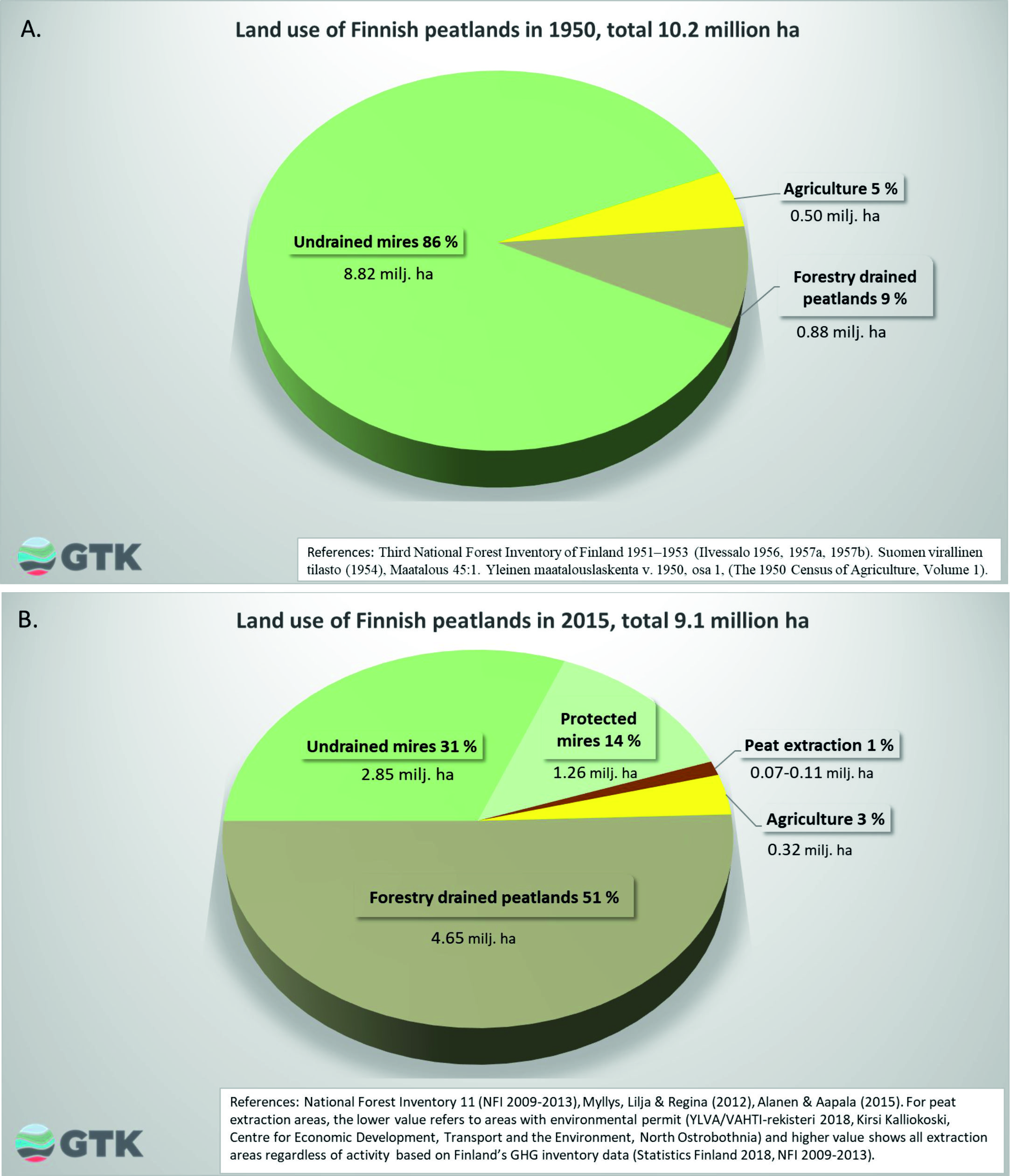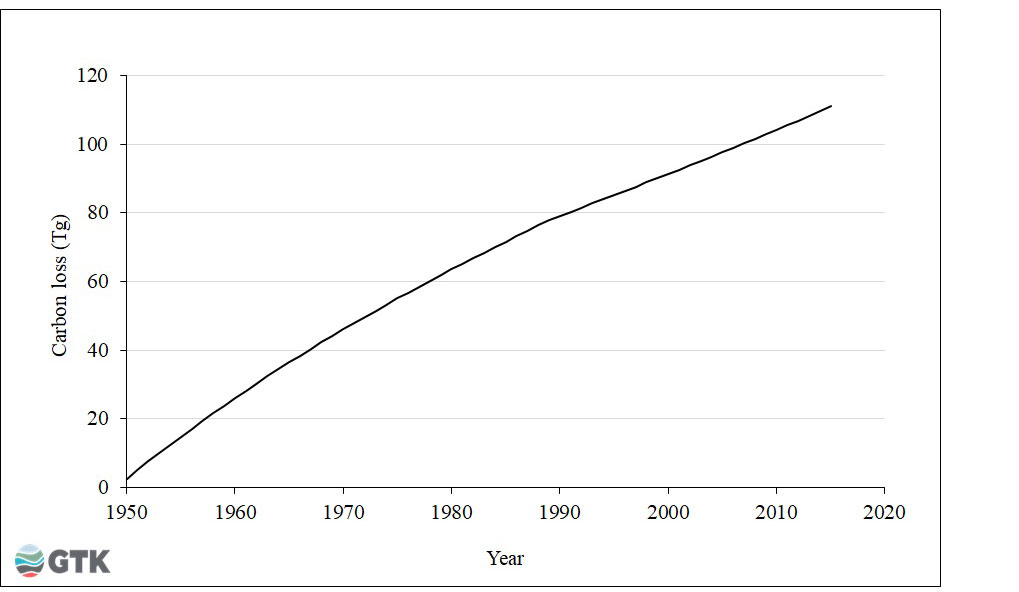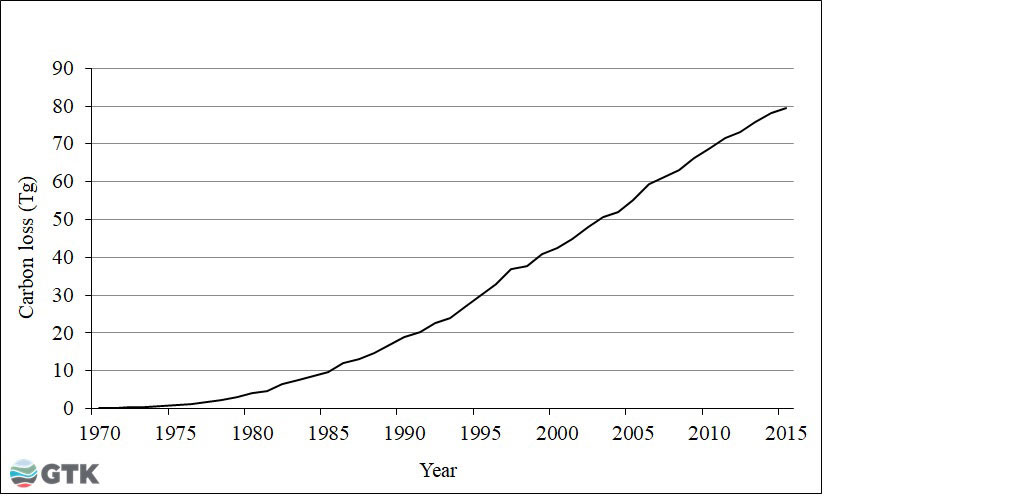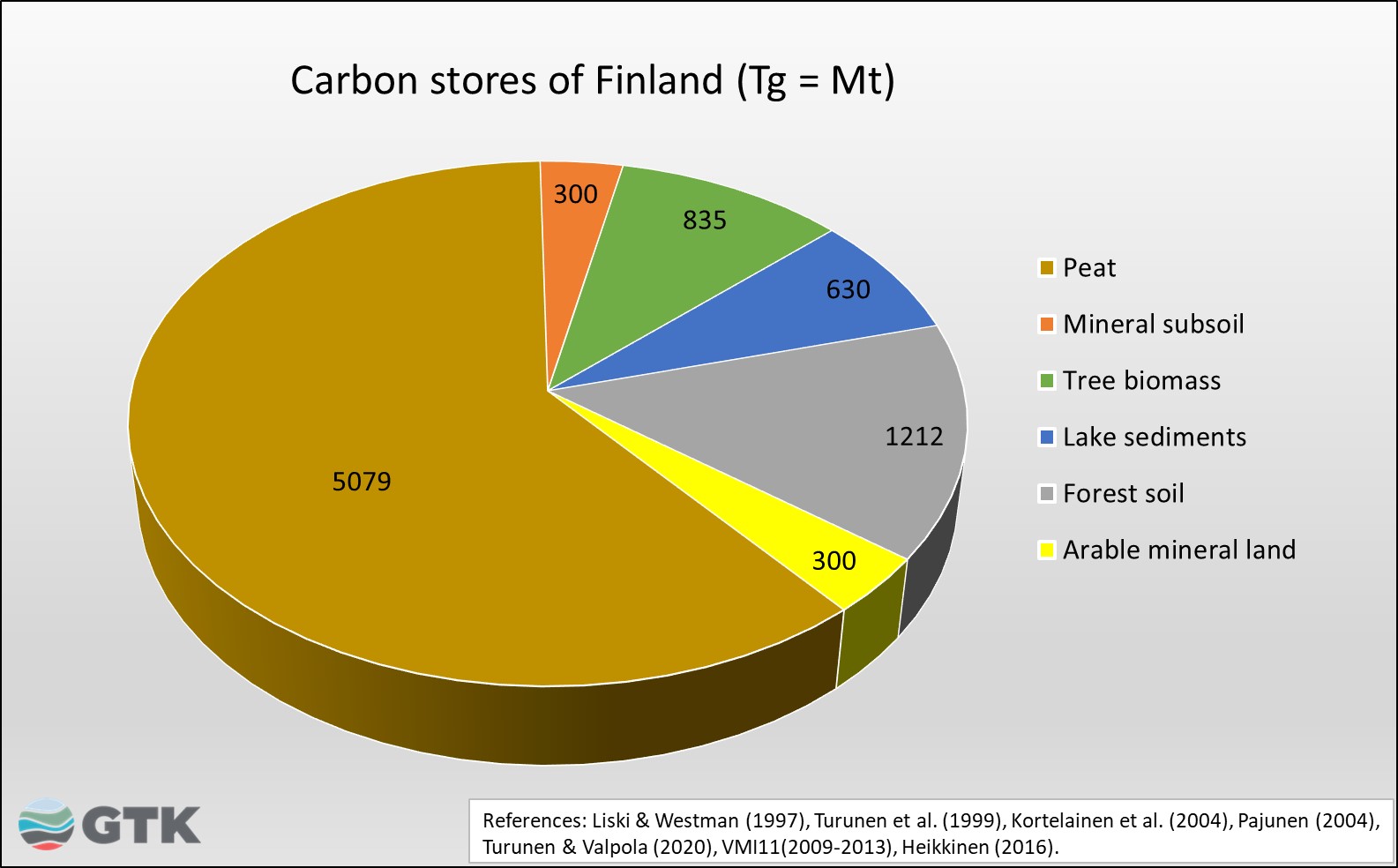Science Blog: The influence of land use on the peatland area and carbon stores of Finland since the 1950s
In Finland, the drainage of peatlands for forestry, agriculture, energy production, road building and peat extraction, as well as other forms of peatland exploitation such as building water reservoirs, has been intensive since the 1950s. During the last 70 years, what has happened to the peatland area and its carbon store? This question is important, since peatlands are by far the most important C store in Finland. Approximately two-thirds of the C reservoir of ecosystems in Finland is in peat. Here, we present some findings from a peatland C project, the main goal of which was to examine the influence of anthropogenic land use on Finnish peatland areas and C stores from 1950–2015 (Turunen & Valpola 2020). In this study, we carried out a new data synthesis of the peatland area and C store in peat in Finland from 1950 to 2015, including all C losses and accumulations of both drained and undrained Finnish peatlands.
The significance of peatlands
Peatlands store more carbon (C) than any other terrestrial ecosystem. The climate during the Holocene has generally favoured peat accumulation and has maintained a large C sink, especially in boreal and subarctic areas. The high abundance of peatlands signals a significant net transfer of C to the soil. Peatlands cover only about 3% of the Earth’s land area, but hold approximately 50% of the 863 Pg of C present in the atmosphere as CO2. In Finland, the role of peatlands is even more important, as they cover about 30% of the land area but include two-thirds of the total C reservoir of Finnish ecosystems. The high importance of both the large peatland C store and its long-term C sinks should be fully recognized and taken into consideration in all discussions. Equally, the significance of changes in the C balance caused by anthropogenic land use should be fully understood and implemented in land management practices.
Undisturbed peatlands generally accumulate C as partially decomposed plants, because the rate of biomass production is greater than the rate of decomposition. About 5–15% of the annual biomass production eventually enters long-term storage in the deeper, solely anoxic layer of a peatland. However, drainage will change the C balance of a mire. The reason for this change is simple: anthropogenic disturbance causes the permanent lowering of the water table, which transforms the C dynamics of mires, usually by terminating peat formation and C sequestration, thus creating a persistent source of atmospheric CO2. Clearly, the sustainable use of peatlands is needed.
Globally, the clearest human threat to peatlands is through agricultural conversion or drainage (for example, for slash-and-burn agriculture, forestry, palm oil and rice). In Finland, over 50% of the peatland area has been drained for forestry (5.7 million ha). Since 1950, different forms of land use have changed the area, state, C store and C balance of Finnish peatlands. Furthermore, the nature of peatland vegetation, peatland biodiversity, biomass distribution and thus the types of C sinks have partly changed.
Development of the peatland area
Since 1950, drastic changes have taken place in the land use of Finnish peatlands, and the impacts on the total peatland area have therefore been significant. In the 1950s, the total peatland area was 10.2 million ha, and 86% of Finnish peatlands were in a natural state. Anthropogenic peatland use was still marginal: the forestry-drained peatland area was only 0.88 million ha and the cultivated peatland area 0.50 million ha (Figure 1A). At the time, other forms of peatland exploitation were marginal.
Since 1950, forestry drainage has been the most extensive land use applied to Finnish mires. During the most intensive drainage period between 1960 and 1980, the annual drainage areas varied between 100 000 and 300 000 ha. By 1980, the area drained for forestry exceeded the natural mire area. Drainage has been most intensive in southern and eastern Finland, where 88–90% of the peatland area has been drained, in contrast to 23% in Lapland. Currently, the forestry-drained peatland area is about 4.7 million ha and the area of undrained mires is 4.1 million ha.
At present, the total peatland area of Finland is 9.1 million ha. Almost 1 million ha or 17% of the originally shallow mire area drained for forestry has lost its peat layer during the past decades. This trend is alarming, since almost 1.8 million ha of the remaining peatlands are less than 30 cm in thickness. Moreover, the area of cultivated agricultural peat soils has decreased significantly from 500 000 ha in 1950 to 320 000 ha in 2015. This area change is large, even if abandoned agricultural fields are included. The loss of cultivated peat area is notable, because the clearance of peat soil for agriculture has continued in Finland and has been relatively extensive since 1990, totalling approximately 43 000 ha. Currently, the area of cultivated agricultural peat soil is about 13% of the total cultivated area.
Peat extraction has also been intensive in Finland since the 1970s. For example, between 1990 and 2015, the area under active peat extraction was between 38 000 and 64 000 ha. Although there is some uncertainty in the statistics regarding the total peat extraction area, it is likely that up to 114 000 ha of peatlands have been used for peat extraction.
The impacts of drainage are not only limited to a decrease in the peatland area, but also include a decrease in the diversity of the remaining peatlands. In southern Finland, about 83% of peatland types have been evaluated as endangered. The most endangered peatland types include meso-eutrophic fens and spruce swamps. The area of protected peatland in Finland is presently about 1.26 million ha or 14% of the current peatland area (Figure 1B). Regionally, however, the protection situation is unbalanced, since 66% of all protected peatlands are situated in northern Finland.

Development of the peatland C store
The present total C store of Finnish peatland ecosystems was estimated at 5618 Tg, which includes 5079 Tg as peat. The results reveal that there have been significant changes in the C store in peatlands due to anthropogenic land use. Large C losses have occurred from forestry-drained peatlands, agricultural peat soils, peat extraction and other forms of peatland exploitation, such as building water reservoirs. Since 1950, different forms of land use of Finnish peatlands have reduced the total peat C store by 3–10%, or approximately 172–510 Tg. The losses of the shallow peatland area alone suggest that the past combined average CO2 and DOC losses from peat have been significantly greater than previously estimated. Since 1950, it can be concluded that approximately 120–360 Tg of C has been lost as peat due to forestry drainage alone. The main source major source of uncertainty is still the representativeness of the soil CO2 gas balance and C store inventory studies in forestry-drained peatlands.
One important finding of this study indicates that there may be a fundamental difference in the C balance between shallow peatlands and peatlands with thick peat layers. One reason behind the increased C and nutrient loss from shallow peatlands may be linked to the fact that the ditches in shallow peatland areas reach the mineral soil below the peat. This may have a drastic impact on the groundwater level, which may increase CO2 emissions due to increased aerobic conditions and induce very long-term erosion and thus long-term export of DOC and nutrients such as N and P. Generally, the importance of DOC export from forestry-drained peatlands and cultivated agricultural peat soils may have been underestimated. In peatland forestry, recently published nutrient export studies from Finland indicate that forestry-drained peatlands have a much greater impact on water quality than previously estimated (Nieminen et al. 2017, 2018).
Overall, the most significant C losses have occurred from forestry-drained peatlands. However, large losses have also occurred from agricultural peat soils, peat extraction and other forms of peatland exploitation such as building water reservoirs. The worst average CO2 losses have come from agricultural peat soils and especially from annual crops. The total cumulative C loss from cultivated agricultural peat soils during 1950–2015 was estimated at 111 Tg (Figure 2). In peat extraction, the total C losses include not only the actual amount of extracted peat, but also emissions through CO2 and DOC from extraction strips, ditches, stockpiles and surrounding peatland areas. In addition, emissions from both the active peat extraction areas and those under preparation or removed temporarily or permanently from extraction should be included. Between 1990 and 2015, the average amount of annually extracted peat was about 22 million m3 or 2.2 Tg C yr-1. Since the 1970s, the total amount of peat extracted has been about 741 million m3 or 73 Tg of C (Figure 3).


Since the 1950s, the total volume of the tree stand on Finnish peatlands has more than doubled from 252 to 551 million m3. This increased biomass production of drained peatlands has partly compensated for the anthropogenic C losses. Since 1950, the total C store of peatland vegetation biomass was estimated to have increased by 92 Tg due to intensive peatland drainage. However, although the general effect of forestry drainage on the total tree biomass has been significant, tree stand growth has also been poor over large areas of drained peatlands. Generally, the total unproductive drainage area where the establishment of tree stands has been ineffective is about 843 000 ha or 20% of the present forestry-drained area.
In addition, undrained mires still represent a significant national C sink. Currently, the annual rate of C sequestration into peat is estimated at 0.82 Tg yr-1, which is approximately 18 million m3 yr-1. However, the annual rate of C sequestration into peat in 2015 was more than 50% less than in the 1950s, when 90% of the peatlands were undrained. From the 1950s, the total C accumulation of the gradually decreasing peatland area was estimated at 88 Tg.
Conclusions
According to our results, peatlands are still by far the most important C store in Finland. The estimated C store in peat is six-fold larger compared to the C store of the total tree biomass and four-fold larger compared to the forest soil C of Finland (Figure 4). However, the different forms of land use of Finnish peatlands since 1950 have reduced the total peat C store by up to 10%.
The total C losses indicate that the actual net C loss of forestry-drained peatlands since the 1950s has been much higher than could be obtained by using the present LULUCF estimates. The historical C loss cannot be explained based on present gas balance measurements. However, it is plausible that the results of both short-term gas measurements and long-term C store inventory results are valid and simply represent the actual monitored timescales. The C balance of drained peatlands can vary depending on the site fertility, peat thickness, water table depth and time elapsed since the original drainage.

The significant anthropogenic C losses from peat soil are still continuing and underline the urgent need for sustainable C management of all peatlands, including the preservation of the C store in existing natural mires, the cessation of land clearing on undisturbed organic soils, improved forest management practices on forestry drained peatlands and improvement of peatland hydrology by restoring the long-term C sinks, especially in areas where the C balance, biodiversity and other ecosystem services can be optimized.
Overall, the wise use of peatlands is called for and can be achieved by sustainable management practices. In recent years, for example, Sphagnum cultivation and Sphagnum biomass harvesting have been proposed as a C-neutral and climate-smart after-use of peatlands and unproductive drainage areas. In Finland, unproductive drainage areas where the establishment of tree stands has been ineffective offer opportunities for mechanical Sphagnum biomass harvesting. However, the practices of this type of business must be responsible and restricted to bog areas that have already been drained. The sustainability must be based on research results such as the renewal of Sphagnum moss and C sinks. In Sphagnum biomass harvesting areas, it might be possible to improve the local hydrological and soil conditions, for example, by cost-effective ditch blockage. This could further improve the recovery of bog vegetation in these unproductive drainage areas after harvesting but could possibly even benefit the larger surrounding peatland areas, which would otherwise be left outside the restoration practices. Overall, the data gathered by the Geological Survey of Finland can help to identify the available raw material and thus suitable areas for such a new and innovative business.
Peatlands are complex ecosystems, and quick solutions are difficult to achieve to improve the C balance of drained peatlands. Instead, a comprehensive approach is needed in order to restore the long-term ecosystem services such as hydrological, C and other nutrient sink functions, as well as the diversity of vegetation communities.
Reference
Turunen, J. & Valpola, S. 2020. The influence of anthropogenic land use on Finnish peatland area and carbon stores 1950–2015. Mires and Peat, Volume 26. Available at: http://mires-and-peat.net/pages/volumes/map26/map2626.php
Text: Jukka Turunen and Samu Valpola
Dr Jukka Turunen is a senior scientist in the Environmental Solutions, Peatland Use and Resource Economics Unit. He has worked at GTK since 2004, specializing in peatland resources, carbon and other elemental accumulation of peatland ecosystems. Currently, he is the manager of the project “Peatlands as nutrient sinks – hydrochemical ecosystem services of mires and their restoration potential”.
Dr Samu Valpola is a head of strategy and planning at GTK, where he has worked since 2006, mostly in peat and peatland mapping and research related positions. He has over 10 years of experience in international co-operation in scientific peatland organizations.
